#sewing lessons
Text
Anyone in Toronto area want to take a sewing class? There's still space available in my Advanced Home Sewing class!
I'll be teaching how to do a collared shirt, trousers or skirt(depending on student preference) and a third -as yet undecided- project, most likely a dress.
It's Wednesday afternoons, and I believe it's $25 for the eight week course.
10 notes
·
View notes
Text

link
#sewing#sew#diy fashion#fashion#easy sewing#pattern#modern sewing#modern fashion#sewing lessons#corset#corset top#corset outfit
11 notes
·
View notes
Text
Fabrics 101: Three Basic Types of Fabric
Let me guide you on the intellectual journey of fabric and the wonders of the grain line. The first step of sewing is understanding what you are trying to sew and how it is formed.
There are three types of fabrics: Woven, Knit, and Non-Woven
Woven Fabrics is created by weaving threads on a loom or other woven devices. The threads going vertical are the warp and threads going horizontal are the weft. These fabrics have little-to-no stretch and are used for more structured garments, like jackets, corsets, tailored pants, and structured dresses.
Knit Fabrics are stretchy fabrics created by the interlocking or interloping of yarn and fibers together. There are two types of knit fabrics: 2-way fabrics and 4-way fabrics. These fabrics are used more for sportswear, t-shirts, and garments that move with the body.
Non-woven Fabrics are not technically fabrics, but designed to resemble fabric and can be used as such. These fabrics are created with either short (stapled) or long fibers bonded together tightly using chemicals, heat, solvents, or mechanically. Some fabrics included interfacing (stabilizer for woven and knit fabrics) and felt.
If you would like some photos or graphics to go along with this posts, I will happy edit and added them for you! :)
Until we hear from our Goddess again.
Praise Be the Needle & Thread -Demi 🖤
#fabric#fabric 101#beginner sewing#sewing lessons#threads of night#patterns#craft#textile#sewing#class#cosplay#learning#education
10 notes
·
View notes
Text
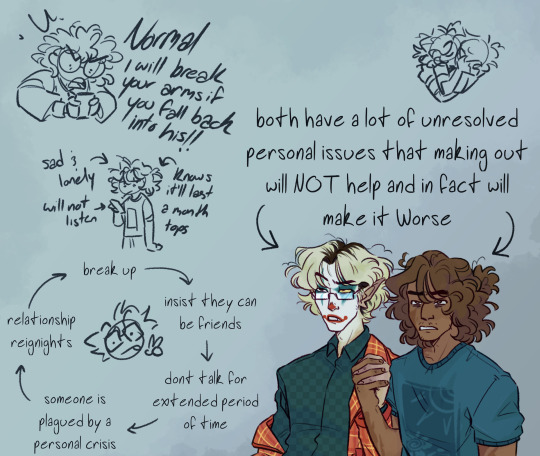
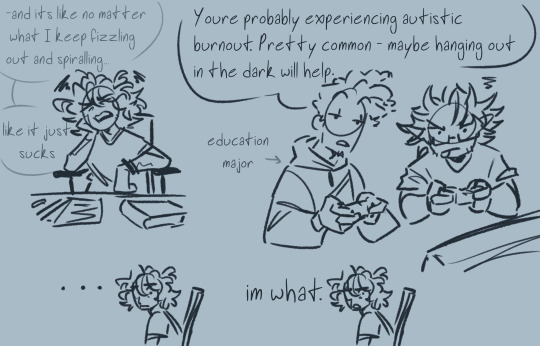
beware of burnout it's so real i'm afraid
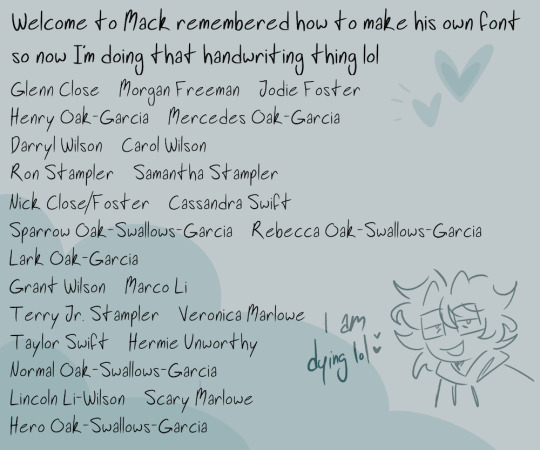
also bc ended up making my writing into a font to avoid killing my hand as much and bc I saw Caden do this, I thought it would be fun to see who y'all think it suits lol
#trust me i am working my way out of it lol#dndads#dungeons and daddies#normal oak swallows garcia#hermie the unworthy#oakworthy#once again i find them really funny being so dysfunctional#and no there is no step prior to the inevitable breakup it just happens#this is just how they are throughout college (they do not talk post graduation the reunion is the 1st time they see each other in years)#lincoln li wilson#taylor swift dndads#hero oak swallows garcia#ik i didnt write out like every character i could have but i was distracted by giving my brother impromptu sewing lessons#i didn't expect that to happen he just kinda showed up like 'I know you'd love to help me with something' like who told you that??#my artwork#edit: I wrote reignite wrong are you kidding me dugjxghshzs it was 4 am oh well
438 notes
·
View notes
Text



Fic writers who wrote migrainous-hunter I love you
Inspired by This fic from @just-here-with-my-thoughts and this one too by lucifer_elliot and this one by @oohhihoney
#star wars#star wars the bad batch#the bad batch fanart#I tried tagging people whom I could find the tumblr#hope it's okay#hope it tags people actually#Anyway I wanted to color them but I've got 100* things to do#including sewing a skirt and making a tiramisu#and a six pages comic#and finish my Omega shooting lesson animatic#this one is almost finished tho!#and answer the nice comments#with other things than ksgshhkK THANKS YOU I LUV YOU ALL AND YOU MADE MY DAy#anyway it's past my bed time#zzzzzzzz
336 notes
·
View notes
Text
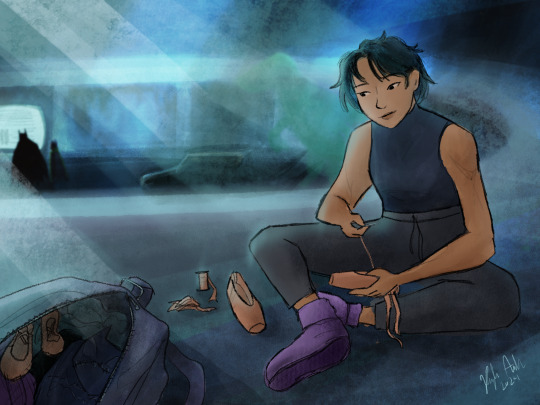
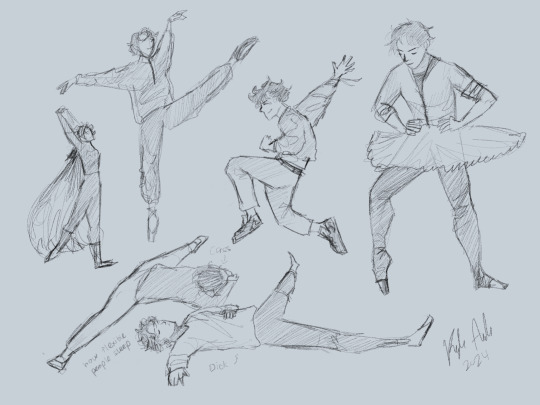

Cass + ballet 🩰 (ft. supportive siblings and good dad Bruce)
I love the idea of Cass enjoying dance. It's an outlet that allows her to express herself without words, and I think she would enjoy the highly technical aspect of ballet combined with its storytelling and emotional side. and as a former dancer I always have fun imagining my fav characters do ballet :)
#ft good older bro dick grayson. and supportive babs and steph. and good dad bruce#sewing pointe shoes in the batcave as one does#cass jus having fun#dick and cass bonding over how they both enjoy stretching and falling asleep in the strangest positions#the rite of passage of trying pointes for the first time#bruce watches her first performance and she gives him a big hug#listen yall when i saw that comic panel of cass seeing ballet for the first time and the way it just Made Sense to her#i havent been normal since#i also just love the idea that eventually cass decides to take lessons and makes friends and learns things she'd never considered because#i think she'd be able to replicate most of the steps just by watching because of her training but she would be coming from#a background focused on martial arts and fighting and not. art and storytelling#and i'd love to see that being explored more. cass using her athletic skillset in something so unrelated to vigilante life#creating beauty instead of causing violence#clearly i've thought about this too much#if you have fic recs PLEASE GIVE THEM TO ME#i haven't read a lot of comics either outside of the first half of cass' batgirl run so recs for comics abt cass welcome as well!#clarisse doodles#dc#cassandra cain#batfam#batgirl#black bat#dc fanart#ballet
52 notes
·
View notes
Note
If I may ask, what’s hidden under wally’s hair? What happened to his eye?
Sally snatched it like the queen she is 💅
#its gone!!! no more!!!#just a ragged gash w/ fluff pokin out!#he got self conscious and let his hair unravel the rest of the way to hide it </3#and thats one tear that Can't be fixed!#that eye got shredded! there's no replacing or repairing it!#but wally learned a valuable lesson - avoid sally#rambles from the bog#wh lights out au#he has to relearn his depth perception and the like#it fucks with his ability to paint/draw/sew for a while#until he adjusts! he gets used to it over the many years
76 notes
·
View notes
Text
me after spending every devil point and demon voucher on nightmare but all I got were duplicate ssr cards (I even collected extra points to grab that discount)
#nana talks#both of them are at 0 rn#I literally haven't pulled a single ur from nightmare so far guys#it's just been me grinding those hard lessons and getting the free cards#meanwhile in the og I pull ur plus cards on my free try what happened in nightbringer#I'm desperate enough for that asmo card to collect every devil point I can though#I like that top and I want somebody to make it real because I'm too lazy to sew it myself
25 notes
·
View notes
Text
Hello friends!
So I've had a patreon for a while and it's never really been my thing but I think the reason I never really got on with it is I just don't feel great about paywalling shit so now ive changed it all to free!
There admittedly isn't a great deal on there but I'm hoping to use it as a platform to share my knowledge and skills to anyone who asks - whether it's a specific metalworking issue, a craft question, or even business related, I'm here to contribute to the community :)
And if that sounds fun or valuable or you just think I'm pretty great, maybe send me a coin or two 😉
I think that's about all I have to say atm, let me know if anything on there is broken or doesn't make sense, I'm not hugely familiar with the platform so it's a but of a learning curve figuring it out
#daughter of mercury metalworks#handmade#community#queer#craft#metal#metalwork#jewellery#metalsmith#custom#art#artist#lessons#metalwork lessons#sewing#customized#maker#blacksmith
11 notes
·
View notes
Text
So now you're telling me secunit's armor doesn't have pockets?? The lack of autonomy assigned to it by virtue of its existence was bad enough, but this is just inhumane.
#Pspsps secunit do you want sewing lessons they are free because you are awesome and cool#the murderbot diaries
48 notes
·
View notes
Text
theyre doing an interest poll for the thh characters on plushwonderland and i am. unfortunately. tempted....
#i can NOT be doing this right now i JUST went on a flight. my moneys!!!!#but. i could have the tonaegiri......in my house............#trying to debate if my sewing lessons from middle school life skills class would be enough to not warrant buying the clothes#why r the clothes sold separately. they r so cold :(((#danganronpa#i could make them kiss i could tuck them into bed i could dunk them in milk and throw them at a wall#i also dont know how many backers each one as received so theres a chance that they just. never get sold to begin with. hrmgh
8 notes
·
View notes
Text
forget hot girl summer imma bout to have busy girl autumn and stressed girl winter
#so basically#big rant incoming#next saturday I have to go to verona with my family#my best fríend told me today that in TWO WEEKS she is having a red carpet themed birthday party#and I have to make the dress#I have to do the proficiency c2 exam this year to take#school starts in two days and I have done like 50% of my summer homework#I have to take a tech exam / certification this year too#I have to buy a new phone#I'm starting singing classes again#I have to go find the right gym and go to the gym#I have more internship hours to do#can't forget about my feminist school group#aaaaand my sewing lessons#yes I am going to be busy no don't ask me how I'm doing
21 notes
·
View notes
Text
Fabrics 101: Holy Grainline
Hello my sweet disciples.
Today we will be focusing on the beauty of the Grainline.
Why is it important and why it must be followed in most instances?
The grainline is determined based of the weave of the fabric. The threads creating the fabric material are running as specific way, in order to build the structure of the material as well as flexibility.
There are three types of grainlines followed in the element of sewing.
Straight Grainline
Cross Grain
True Bias

The grain of fabric is important because it will determine how the fabric falls onto the body while being worn. In addition, if a fabric is cut off grain it can create an weird twist, or hang drastically different from one side to the other. We follow the grain of the fabric like sewing law (in most cases). Sometimes you can use different grains to create different effects in the sewing techniques and designs; however we will discuss that in future lessons.

The straight of grainline is parallel to the selvage of the fabric material.
What is the selvage you may ask? It is tightly woven ends of the fabric created during the process of finishing a length of fabric. It is visible different than the rest of the fabric in weave, texture, and/or color.
Fun Fact: If you ever get a multi-colored fabric with one selvage white, than there may be a helpful addition to your material. There will mostly be individual colored circles on the fabric, which match the individual colors within the fabric, itself. This is used to help find color matches for accents as well as just show the variation of each color separately.
If the selvage is torn of and/or not indicated, then you can find the straight of grainline based off the lack of stretch in the weaving of the fabric. This leads of to the determining the cross-grain of the fabric.
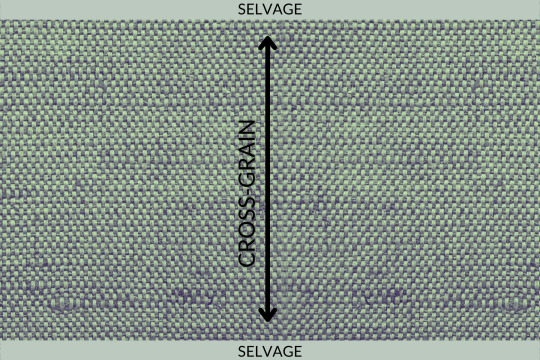
The cross-grain is determined by the slight stretch within the weave. When looking for the straight and cross grain, I usually try to stretch the fabric in each direction to see where the give and take are within threading.
If I get no stretch, then I know it is the straight of grain. If I get s small amount of stretch, then I know it is the cross grain. I would indicate this to myself with chalk or a pencil on the wrong side of fabric near the edging. Doing this will create a "selvage-like" indication for you when lining up your pattern pieces.

Now, the final grainline is the true bias, which is the stretchiest grain of fabric. It is used to create bias strips for finishing, more movement in dresses and skirts, and other fabric manipulation techniques.
Fun Fact: The cutting a skirt, dress, or pants on bias, it is advised to have your fabric pieces hang overnight in order to let the fabric "settle". This means while the fabric is hanging, the weight of the fabric will pull in places with the most stretch causing hems to change lengths in those place. By letting the pieces settle before putting the garment together, you are most likely to caught the change in hems early and know where to fix the issues during the fitting process. In addition, when cutting hems make sure to cut slightly longer just in case the fabric decides to bounce back into place. This way if you do leave wiggle room. you won't be left with a hem too short! (I can speak more to this later, if asked 😋)
The true bias is measured 45° from selvage to selvage. It will give you the best stretch for projects and manipulations. If looking for the true bias, then create a square on the back of your fabric (making sure to follow both the grain and cross grain). Once you have created your box, draw a line from one in to the other creating a diagonal line within the box. This is your true bias on the fabric. I've used this technique ever since I started sewing, especially if I want to make sure it is truly the bias. I can eyeball is and you will possibly be able to once you start sewing more, but it is always nice to make sure sometimes.
Now I know this post is already very long, so I will keep knits and non-woven short and sweet. I can go more in-depth in a future post if you would like, just comment below.
Knits follow the same rules as woven when cutting on the grainlines. The only knit that has a more flexible grainline is a 4-way stretch because it is developed to stretch the same way in each direction; however, I still always follow the sewing law of grainlines when cutting out my patterns. This just allows me to have more choice if I can running out of room or need to piece something together.
Non-woven have no grainline, but I treat the fabric as though it has one just to be safe rather than sorry.
My last detail I have for you that if you ever cut a complete garment on the cross grain instead of the straight of grain, be prepare for your garment to tear apart into pieces. I have never had this happen to me, but I will never forget the story my teacher told me in college about a student that created their whole project on the cross grain... The cross grain is not built to withstand a lot of tension and stress, so the student's model inhaled a deep breathe and unknowingly started to break apart at not only the seams, but everywhere there was too much stress on the fabric. 😦 (Dun dun dunnnnn)
Now is this a true story? I have no idea, but I don't want to find out and I don't want you lovelies to find out either. So Beware!
Until we hear from our Goddess again.
Praise Be the Needle & Thread -Demi 🖤
#fabric 101#sewing#sewing lessons#threads of night#fabric#fashion#learning#beginner sewing#grainline#grains#goddess of sewing#seamstress#style#cosplay#cute#writers#illustration#canva#cleotha#cleotha goddess of sewing
12 notes
·
View notes
Text
you know, when I clicked on a video called “Making a Historically Accurate Gonzo Cosplay from The Muppet Christmas Carol” I wasn’t expecting a history lesson about Victorian labor conditions, or gendered buttons, or the usage of mercury in Victorian hat-making
but I am riveted
#rhi muses#I love a history lesson and I love a silly sewing project and this woman combines both of these while also having a really soothing voice#her name is nicole rudolph btw and I highly recommend#(alongside bernadette banner and rachel maksy and a bunch of others because apparently historical fashion youtube is my favorite place now)#also the best part about her historically accurate gonzo cosplay#is that it's pretty much just a piece by piece recreation of the actual outfit on the actual muppet just made for a person#because the clothes in muppet christmas carol are all incredibly accurate
297 notes
·
View notes
Text
I just had my first violin lesson and it wasn't as scary as I was afraid of.
#i'm unlearning that whole thing about how once you try something you have to commit to being perfect at it#and trying a bunch of new stuff#i have sewing lessons and swim lessons this week too#mid-30s and having a second childhood or something idk
26 notes
·
View notes
Text
i bought a quilting foot for my sewing machine 🤑 it cost 20 euros which hurt but. it's for a good cause
#i tried to quilt with my regular sewing foot but it got bunched up in places and then it sewed those bunches in place so ok. lesson learned#no shortcuts </3
20 notes
·
View notes